Establishment and Research of Cotton Stalk Moisture Content–Discrete Element Parameter Model Based on Multiple Verification
Abstract
:1. Introduction
2. Materials and Methods
2.1. Testing Material
- Hj—cotton stalk moisture content, %;
- Mjs—sample cotton stalk wet weight, g;
- Mjg—sample cotton stalk dry weight, g.
2.2. Cotton Stalk Pile-Up Angle Physical Experiment
2.3. Construction of Cotton Stalk Discrete Element Model
2.4. Simulation Method of Cotton Stalk Stacking Angle and Determination of Test Scheme
2.4.1. Simulation Method of Cotton Stalk Stacking Angle
2.4.2. Determination of Plackett–Burman Design, Climbing Design and Box–Behnken Design
2.5. Confirmation of Verification Test Plan
3. Results and Discussion
3.1. Construction of Cotton Stalk Moisture Content–Accumulation Angle Model
3.2. Results and Analysis of Significant Parameter Screening
3.3. Determination of Optimal Interval of Significance Parameters
3.4. Establishment of Cotton Stalk Stacking Angle–Discrete Element Parameter Model
3.5. Validation of Cotton Stalk Stacking Angle–Discrete Element Parameter Model
3.6. Moisture Content–Discrete Element Parameter Model Construction and Stacking Angle Test Verification
3.7. Experimental Verification of Throwing and Returning Device
4. Conclusions
- (1)
- Based on the physical experiment of the cylinder-lifting method, the moisture content–accumulation angle model of cotton stalk with moisture content in the range of 26.47~52.13% was successfully constructed. Through the statistical analysis, the correlation coefficient of the model was as high as 0.9993, showing a very high goodness of fit.
- (2)
- Through the combination of the Plackett–Burman test and climbing test, the significant parameters of cotton stalk discrete element with moisture content in the range of 26.47~52.13% and their optimal intervals were systematically determined: the rolling friction coefficient between cotton stalks is 0.06~0.08, the static friction coefficient between cotton stalks is 0.35~0.45 and the static friction coefficient between cotton stalks and steel is 0.35~0.45. The cotton stalk stacking angle–discrete element parameter model was established by the Box–Behnken test. The model had a p < 0.0001, and the relative error was only 2.67%.
- (3)
- Based on the moisture content–accumulation angle model and the accumulation angle–discrete element parameter model, the moisture content–discrete element parameter model of cotton stalk was established. The reliability of the cotton stalk moisture content–discrete element parameter model was verified by the cylinder-lifting method and the plate extraction method, and the relative error was only 2.79%. The simulation test and field test were used to verify the effect of throwing and returning to the field. The relative error was only 4.75% by comparing the effect of throwing and returning to the field, with the throwing uniformity as the test index. The practicability and reliability of the moisture content–discrete element parameter model were further verified, providing the design basis and support for the mechanization research of cotton stalk conveying, throwing and returning to the field in Xinjiang.
- (4)
- Based on the established moisture content–discrete element parameter model and stacking angle–discrete element parameter model, through reasonable mathematical derivation and model analysis, the optimal combination of discrete element significant parameters of cotton stalk under different moisture content conditions can be accurately solved. This method is not only universal and suitable for the calibration of cotton stalk parameters under different moisture contents, but also its practicability was fully verified.
Author Contributions
Funding
Data Availability Statement
Conflicts of Interest
References
- Wang, J.L.; Guo, F.; Wang, Y.B.; Zhang, X.J.; Gan, L.L.; Wang, X.H. Analysis of upland cotton fiber quality in Aksu Prefecture of Xinjiang in 2021. J. China Cotton. 2024, 51, 33–37. [Google Scholar]
- Xie, W.Y.; Ma, S.H.; Zhao, L. Research status and technical analysis of straw crushing equipment. J. Xinjiang Agric. Mech. 2023, 5, 14–17+24. [Google Scholar] [CrossRef]
- Song, G.P. Countermeasures for comprehensive utilization of crop straw. J. Hubei Polytech. Univ. 2002, 38, 9–12. [Google Scholar]
- Qin, M.; Dong, Q.; Zhong, X.H.; Zhang, M.M.; Li, W.W.; Song, H.; Zhai, L.X. Research progress of conservation tillage in China. J. Henan Agric. Sci. 2023, 52, 1. [Google Scholar]
- Lu, C.Y.; Luo, X.W.; Li, H.W.; Zang, Y.; Ou, Y.G. Progress and suggestions of conservation tillage in China. J. Strateg. Study CAE 2024, 26, 103–112. [Google Scholar]
- Wang, J.; Chen, B.; Wang, J.L.; Lu, Y.T.; Wang, M.; Song, Y.; Han, H.Y.; Wang, F.Y. Effect of different mechanization methods of straw returningon growth, yield and quality of cotton. J. Agric. Res. Arid Areas 2021, 39, 18–24+56. [Google Scholar]
- Qi, L.; Cao, W.L.; Lu, Y.T.; Wang, M.; Ying, Y.K.; Tan, X.Z.; Yan, P.P.; Li, Z.Q. The present application and thinking about technique of cotton stalks returned to field in Xinjiang corps. J. Anhui Agric. Sci. 2015, 43, 154–156. [Google Scholar]
- Ma, Z.T.; Zhao, Z.H.; Quan, W.; Shi, F.G.; Gao, C.; Wu, M.L. Calibration of discrete element parameter of rice stubble straw based on EDEM. J. Chin. Acad. Agric. Sci. 2015, 43, 154–156. [Google Scholar]
- Zhao, Z.H.; Wu, M.L.; Xie, S.P.; Luo, H.F.; Li, P.C.; Zeng, Y.; Jiang, X.H. Parameter calibration for the discrete element simulation of soil-preceding rice stubble and its rotary tillage trajectory. J. Trans. Chin. Soc. Agric. Eng. 2024, 40, 72–82. [Google Scholar]
- Wang, W.Z.; Liu, W.R.; Yuan, L.H.; Qu, Z.; He, X.; Lu, Y.L. Simulation and experiment of single longitudinal axial material movement and establishment of wheat plants model. J. Trans. Chin. Soc. Agric. Mach. 2020, 51, 170–180. [Google Scholar]
- Wang, X.; Tian, H.Q.; Xiao, Z.Q.; Li, D.P.; Ren, X.G.; Cheng, X.; Liu, F. Determination of corn straw stem node contact physical parameters and calibration of discrete element numerical simulation. J. Jiangsu Agric. Sci. 2023, 51, 162–170. [Google Scholar]
- Zhang, X.R.; Hu, X.H.; Liu, J.X.; Yang, Y.M.; Li, Y. Calibration and verification of bonding parameters of banana straw simulation model based on discrete element method. J. Trans. Chin. Soc. Agric. Mach. 2023, 54, 121–130. [Google Scholar]
- Zhang, J.X.; Zhang, P.; Zhang, H.; Tan, C.L.; Wan, W.Y.; Wang, Y.C. Discrete element simulation parameters calibration for xinjiang cotton straw. J. Trans. Chin. Soc. Agric. Mach. 2024, 55, 76–84. [Google Scholar]
- Zhang, B.C.; Chen, X.G.; Liang, R.Q.; Wang, X.Z.; Meng, H.W.; Kan, Z. Calibration and test of contact parameters between chopped cotton stalks using response surface methodology. J. Agric. 2022, 12, 1851. [Google Scholar]
- Liang, R.Q.; Chen, X.G.; Zhang, B.C.; Wang, X.Z.; Kan, Z.; Meng, H.W. Calibration and test of the contact parameters for chopped cotton stems based on discrete element method. J. Int. J. Agric. Biol. Eng. 2022, 15, 1–8. [Google Scholar]
- Liu, F.Y.; Zhang, J.; Li, B.; Chen, J. Calibration of parameters of wheat required in discrete element method simulation based on repose angle of particle heap. J. Trans. Chin. Soc. Agric. Eng. 2016, 32, 247–253. [Google Scholar]
- Zhu, X.H.; Fu, S.K.; Li, X.D.; Wei, Y.Q.; Zhao, W. General method for discrete element parameters calibration of goat manure with different moisture contents. J. Trans. Chin. Soc. Agric. Mach. 2022, 53, 34–41. [Google Scholar]
- Wang, Y.X.; Liang, Z.J.; Zhang, D.X.; Cui, T.; Shi, S.; Li, K.H.; Yang, L. Calibration method of contact characteristic parameters for corn seeds based on EDEM. J. Trans. Chin. Soc. Agric. Eng. 2016, 32, 36–42. [Google Scholar]
- Yin, Y.W. Design and Experimental Research of the Cotton Stalk Chopper. Ph.D. Thesis, Hunan Agricultural University, Changsha, China, 2016. [Google Scholar]
- Wang, W.W.; Cai, D.Y.; Xie, J.J.; Zhang, C.L.; Liu, L.C.; Chen, L.Q. Parameters calibration of discrete element model for corn stalk powder compression simulation. J. Trans. Chin. Soc. Agric. Mach. 2021, 52, 127–134. [Google Scholar]
- Jin, W.; Zhang, X.J.; Ding, Y.C.; Bai, S.H.; Liu, W.P.; Zhou, X.C. Experiment on suspension separation of residual film and lmpurity based on EDEM-Fluent coupling. J. Trans. Chin. Soc. Agric. Mach. 2022, 53, 89–98. [Google Scholar]
- Wan, X.Y.; Liao, Q.X.; Jiang, Y.J.; Shan, Y.Y.; Zhou, Y.; Liao, Y.T. Discrete element simulation and experiment of mechanized harvesting and chopping process for fodder rape crop harvest. J. Jilin Univ. 2022, 52, 2735–2745. [Google Scholar]
- Wang, L.M.; Fan, S.Y.; Cheng, H.S.; Meng, H.B.; Shen, Y.J.; Wang, J.; Zhou, H.B. Calibration of contact parameters for pig manure based on EDEM. J. Trans. Chin. Soc. Agric. Eng. 2020, 36, 95–102. [Google Scholar]
- Yuan, Q.C.; Xu, L.M.; Xing, J.J.; Duan, Z.Z.; Ma, S.; Yu, C.C.; Chen, C. Parameter calibration of discrete element model of organic fertilizer particles for mechanical fertilization. J. Trans. Chin. Soc. Agric. Eng. 2018, 34, 21–27. [Google Scholar]
- Zhu, K. Experimental Study on Mechanical Characteristic of Cotton Stalk. Ph.D. Thesis, Huazhong Agricultural University, Wuhan, China, 2014. [Google Scholar]
- Shi, N. Peeling method of cotton stalk and development of rubbing peeling machine. Ph.D. Thesis, Northwest A&F University, Xianyang, China, 2018. [Google Scholar]
- Zhang, P. Parameter Calibration and Crushing Verification Test of Xinjiang Cotton Straw Based on Discrete Element. Ph.D. Thesis, Xinjiang Agricultural University, Urumqi, China, 2023. [Google Scholar]
- Du, X.J.; Li, Y.D.; Yan, S.T.; Li, X.Z.; Song, Z.H.; Li, F.D. Mechanics Characteristics of Cotton Stalks. J. Trans. Chin. Soc. Agric. Mach. 2011, 42, 87–91. [Google Scholar]
- Li, P.P.; Wu, S.; Zhang, X.L.; Wang, J.Z.; Xu, Y.F. Parameter optimization of vertical screw mixing for tomato straw and fermentation strains. J. Trans. Chin. Soc. Agric. Mach. 2016, 47, 114–120. [Google Scholar]
- Jia, H.L.; Deng, J.Y.; Deng, Y.L.; Chen, T.Y.; Wang, G.; Sun, Z.J.; Guo, H. Contact parameter analysis and calibration in discrete element simulation of rice straw. Int. J. Agric. Biol. Eng. 2021, 14, 72–81. [Google Scholar]
- Zhang, T.; Liu, F.; Zhao, M.Q.; Ma, Q.; Wang, W.; Fan, Q.; Yan, P. Determination of corn stalk contact parameters and calibration of discrete element method simulation. J. China Agric. Univ. 2018, 23, 120–127. [Google Scholar]
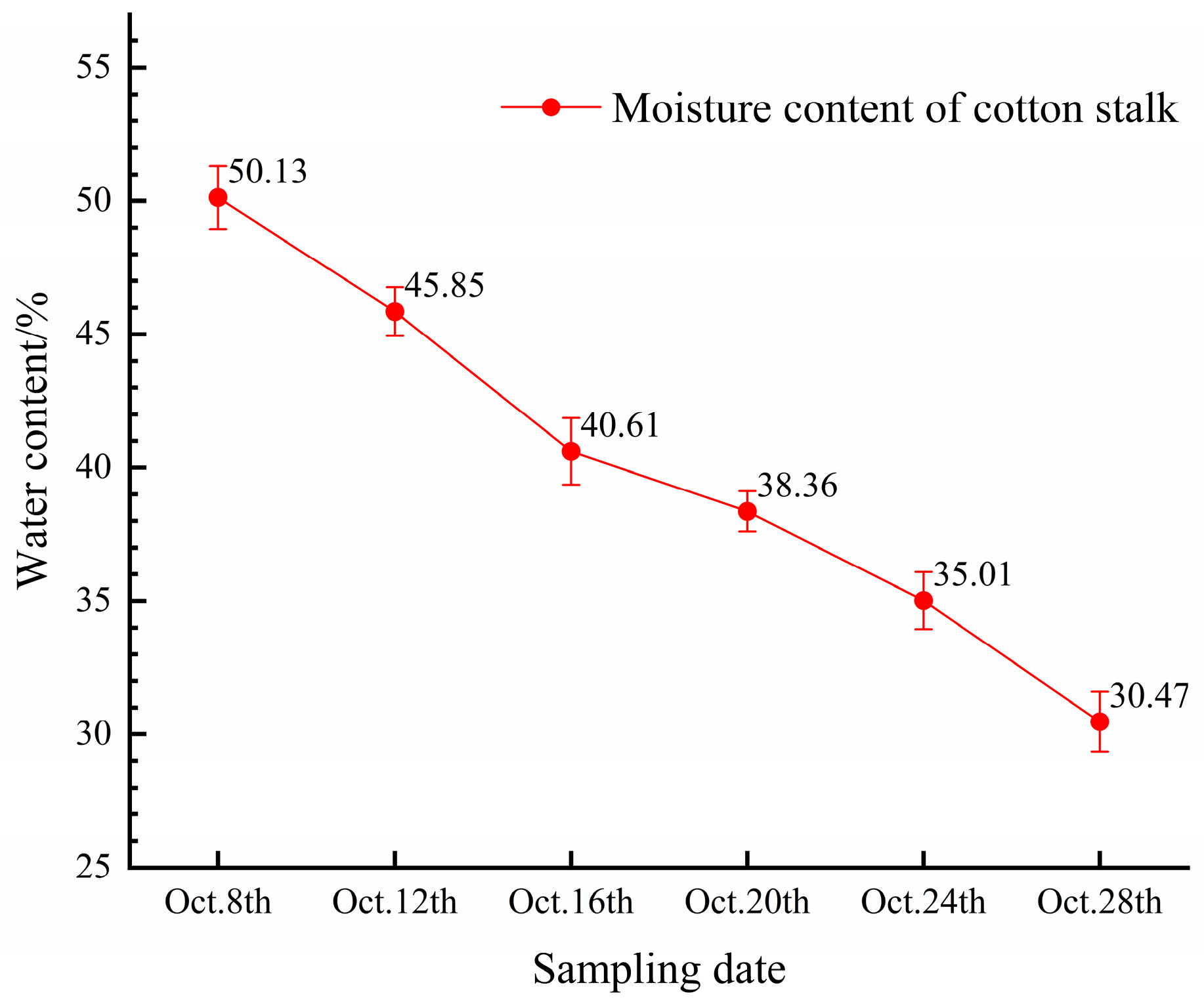
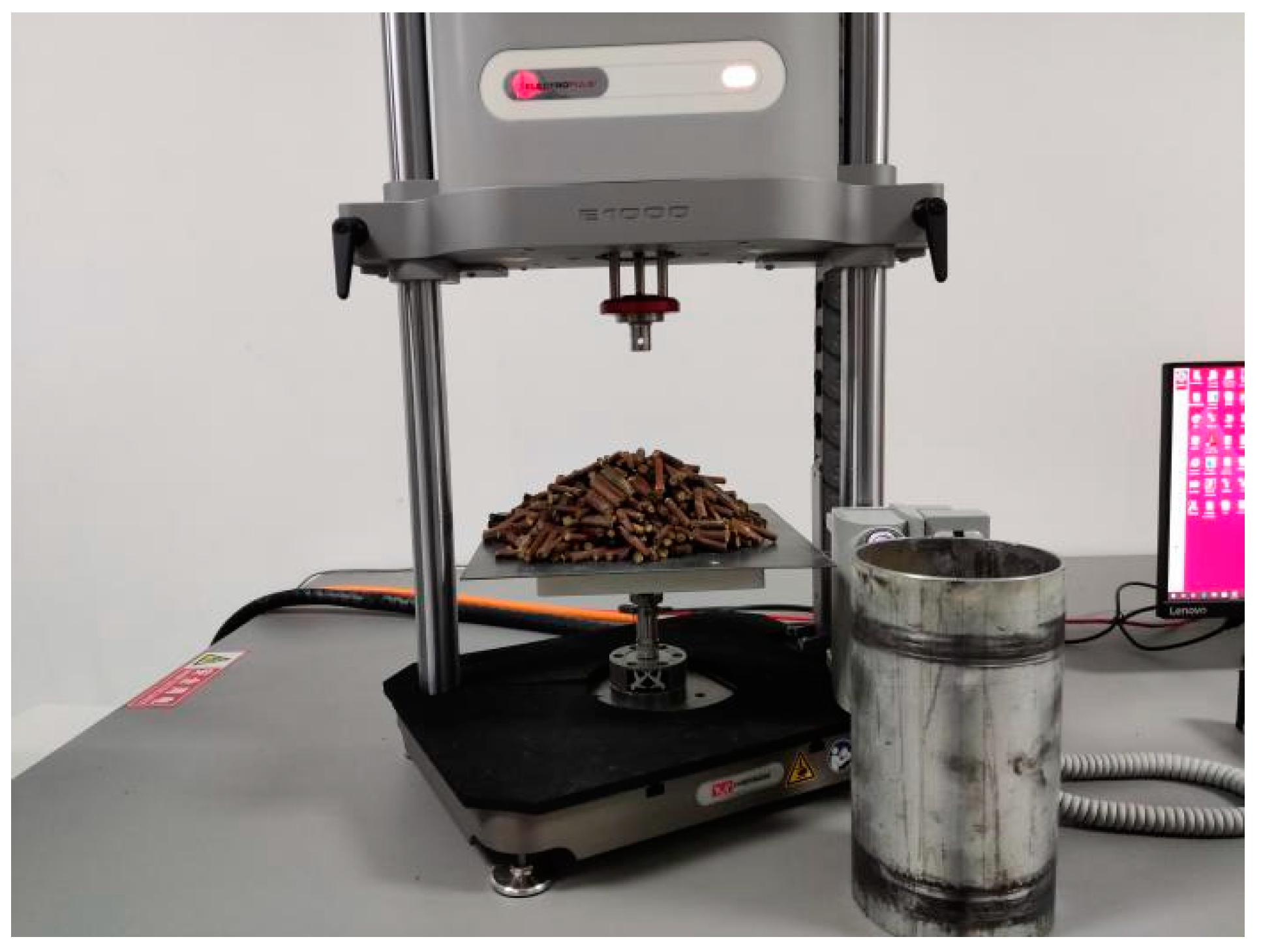

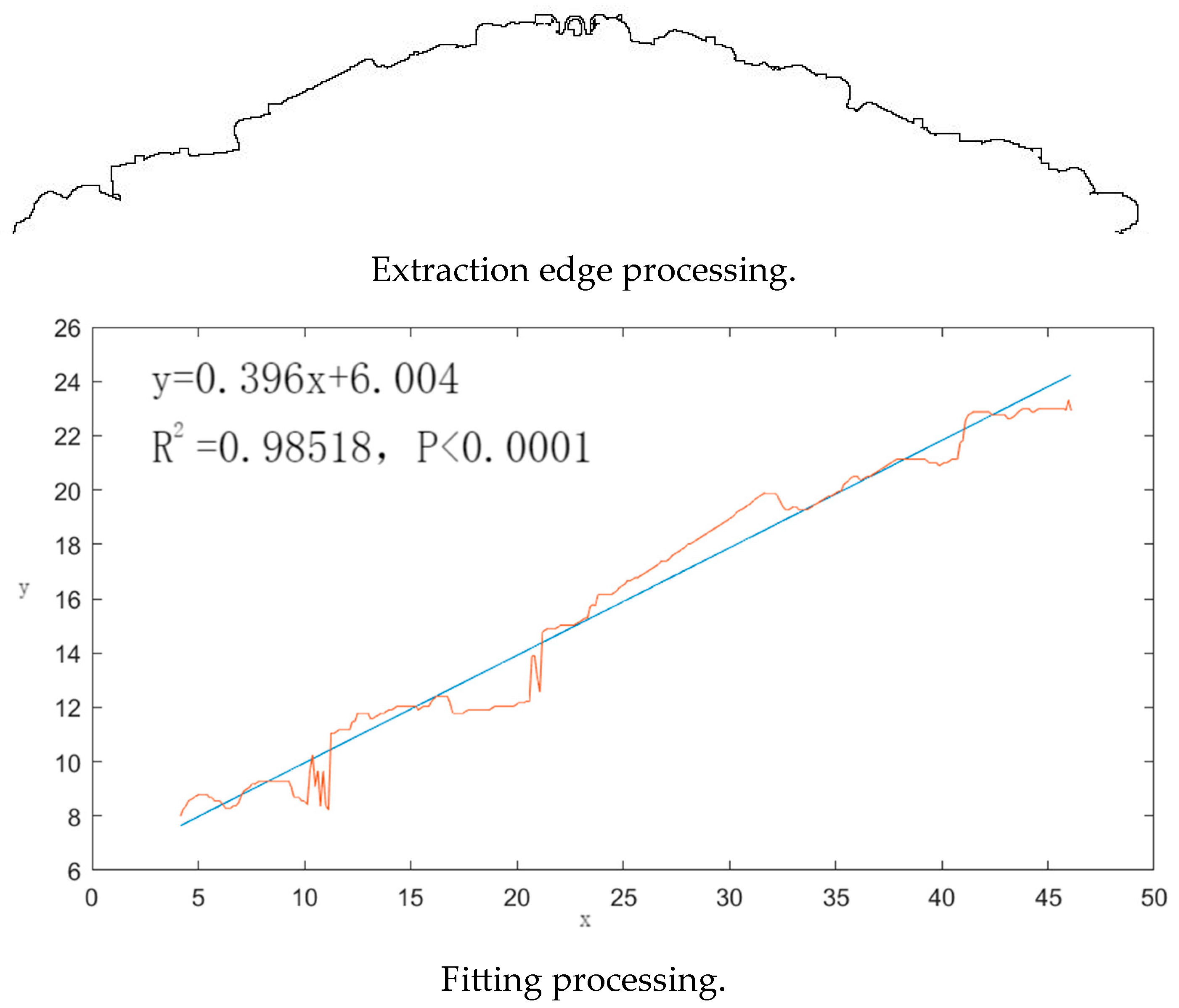
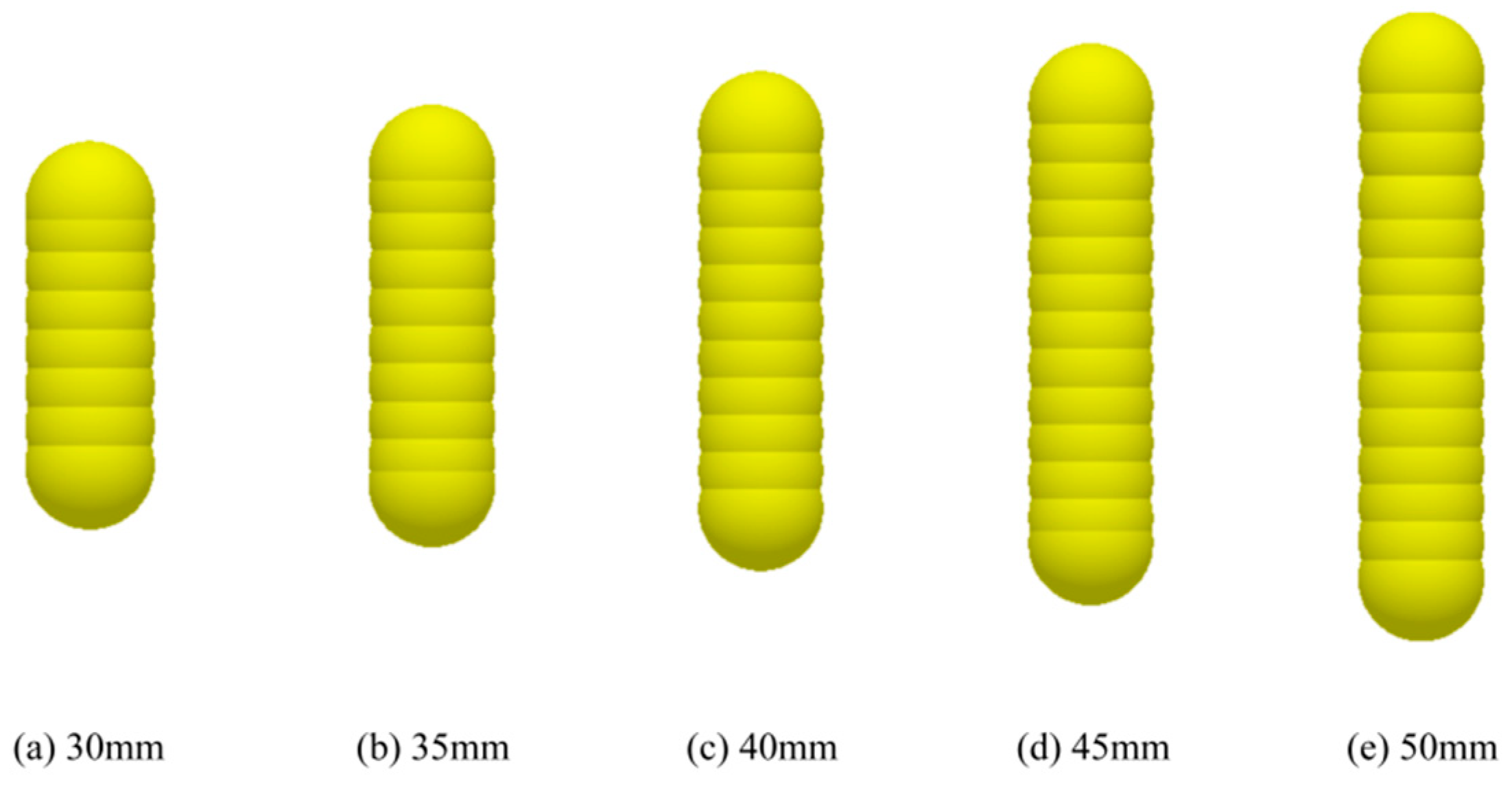
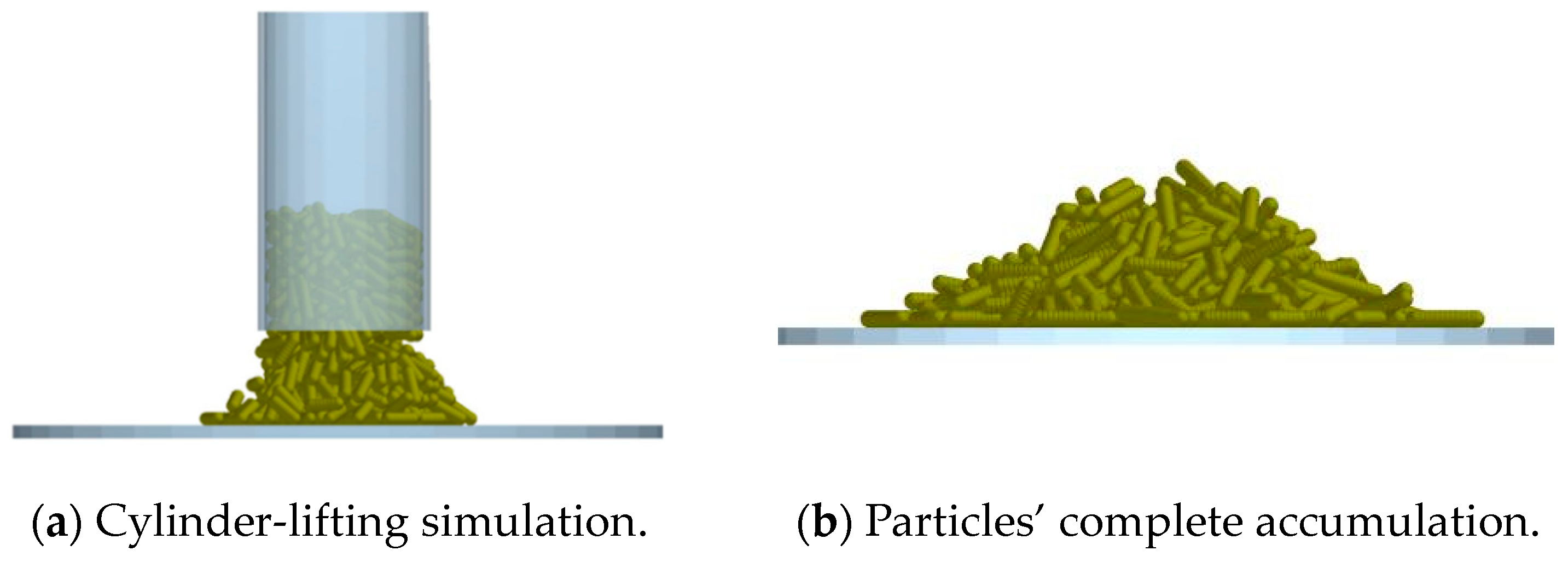


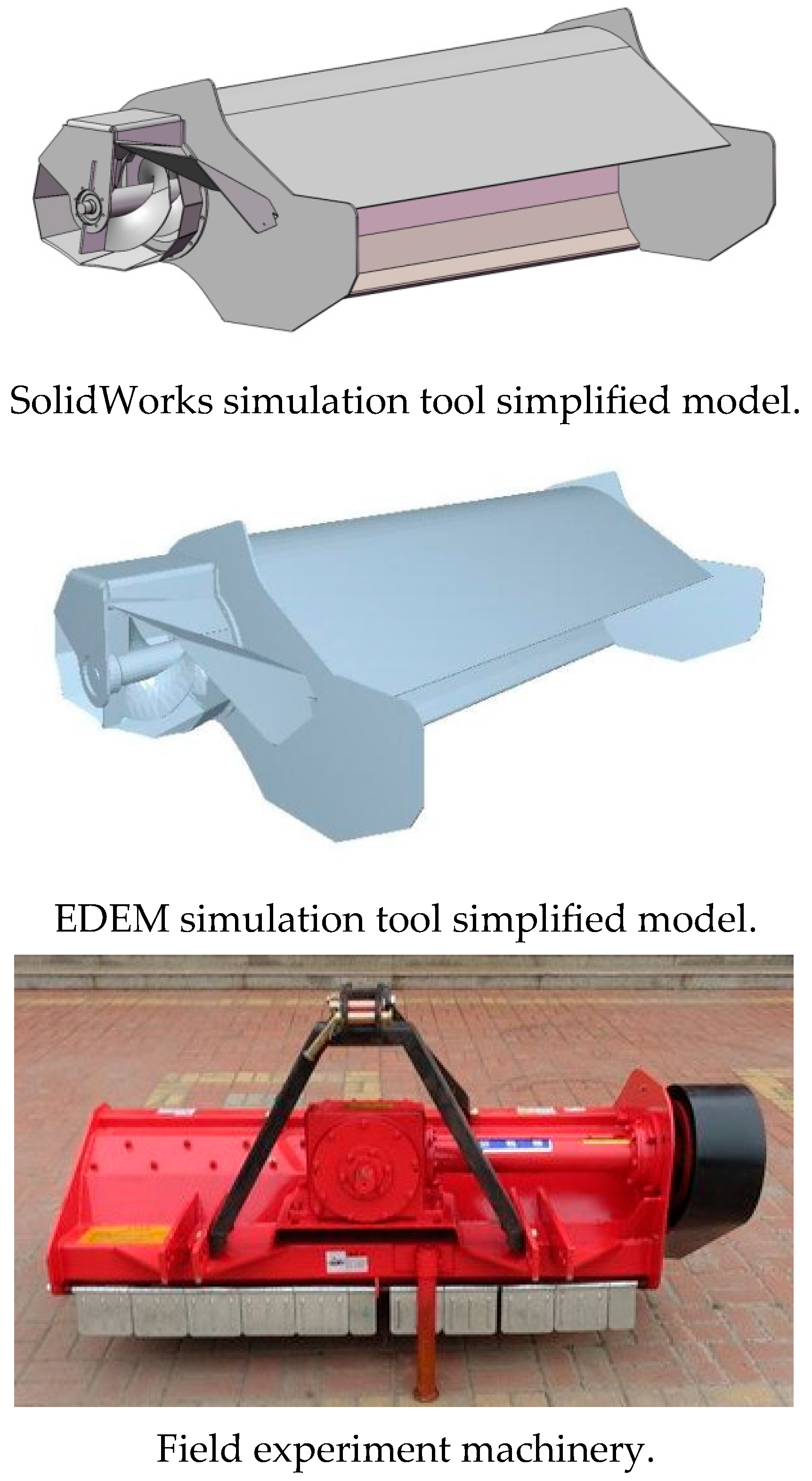
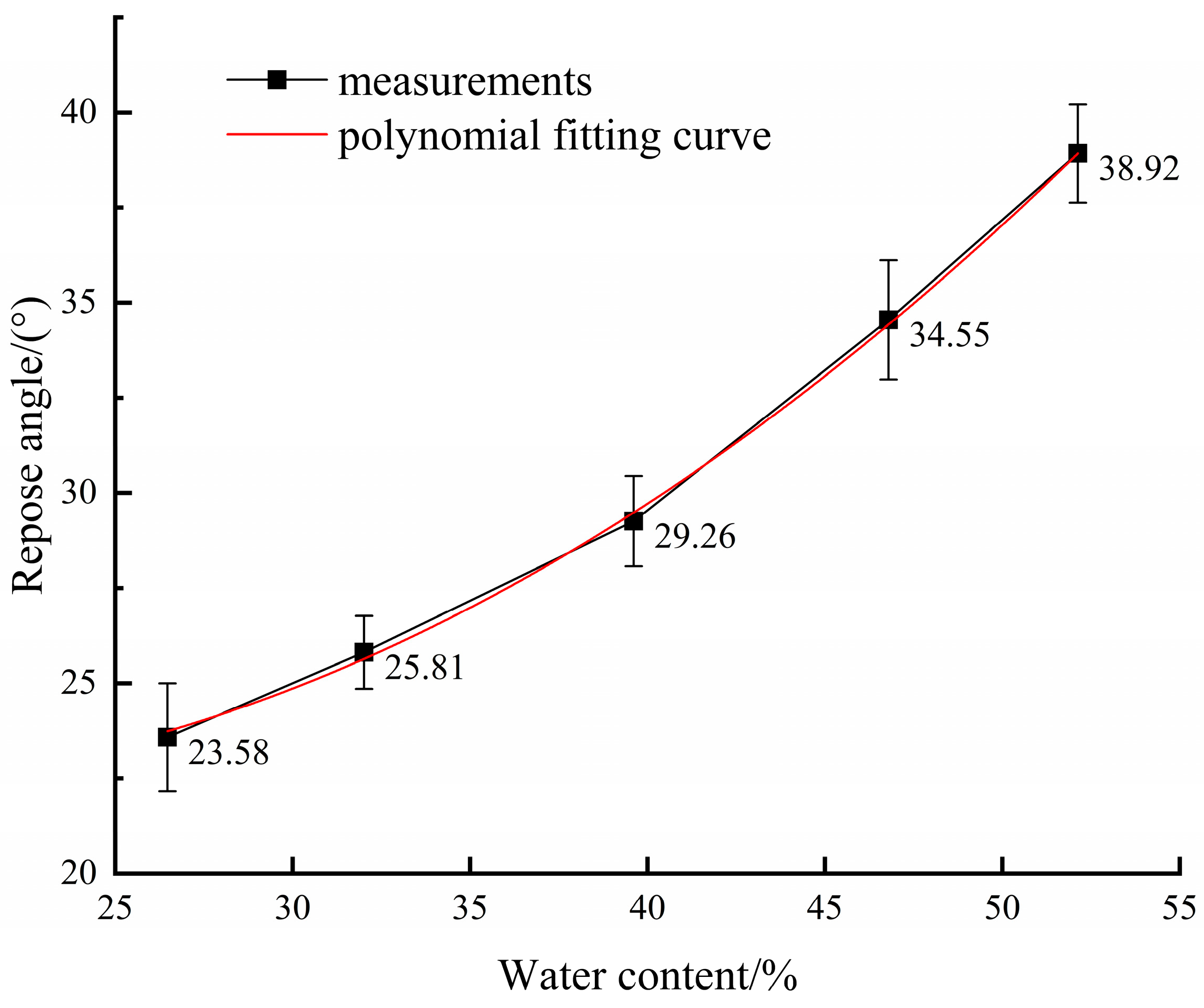
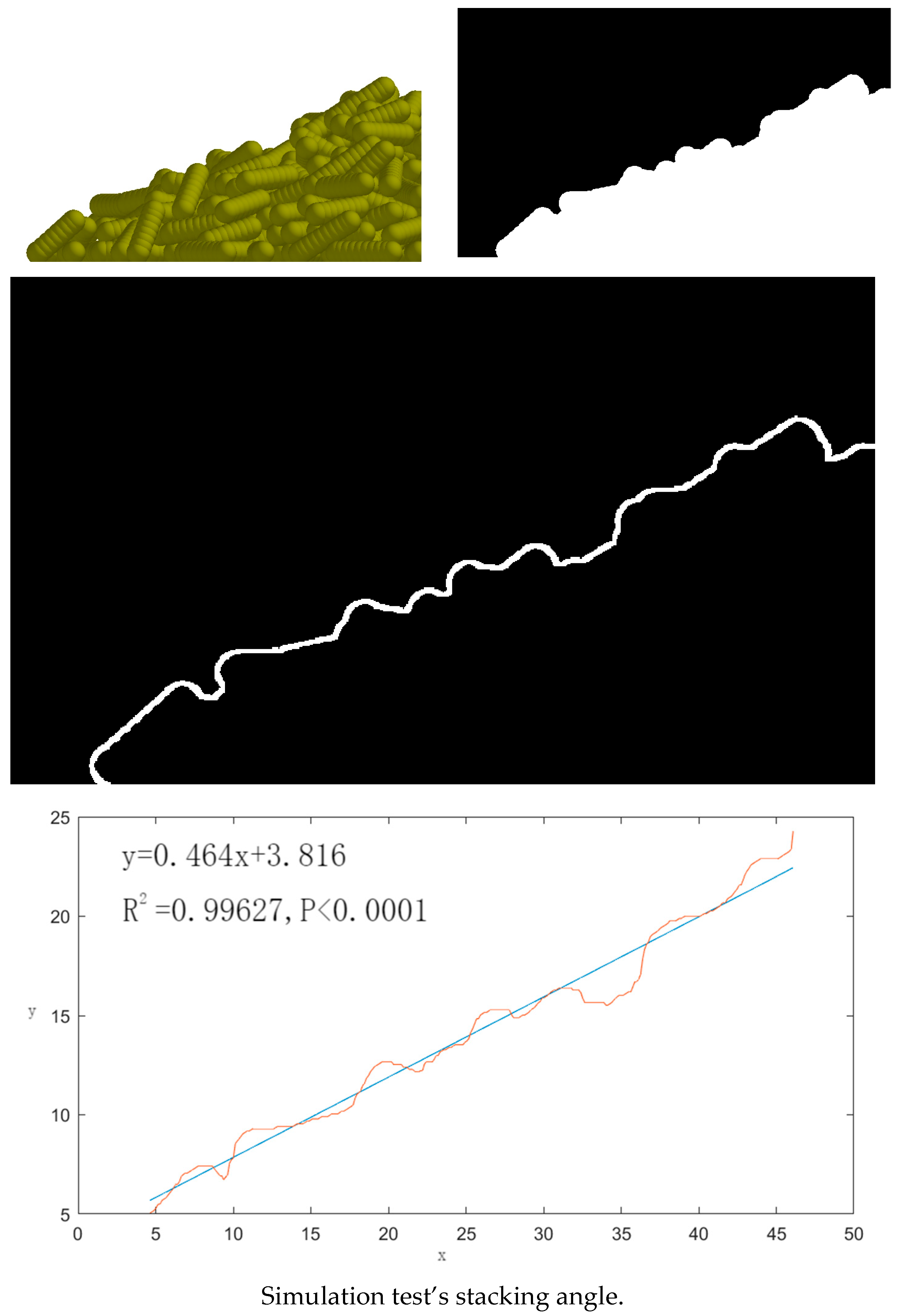
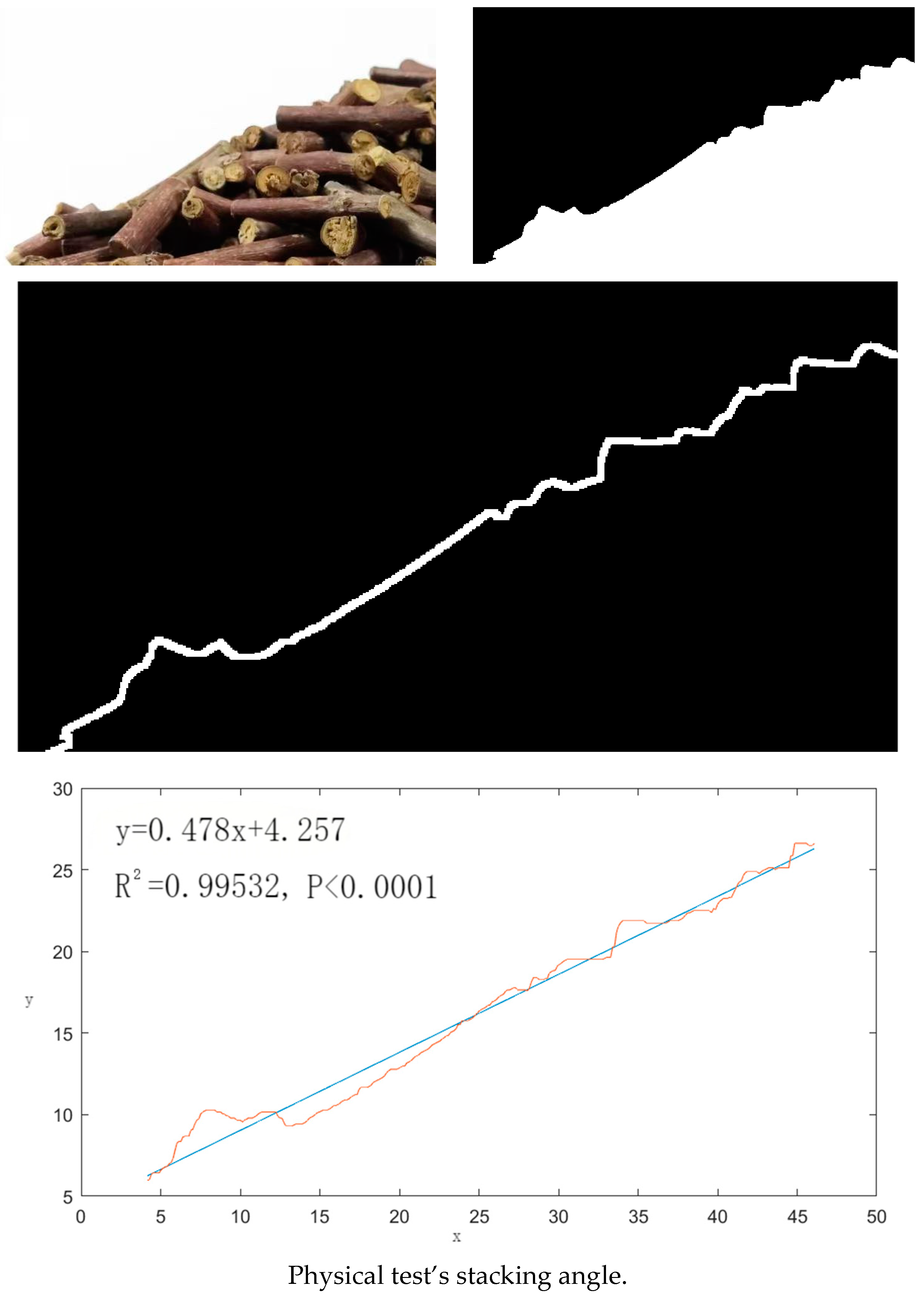
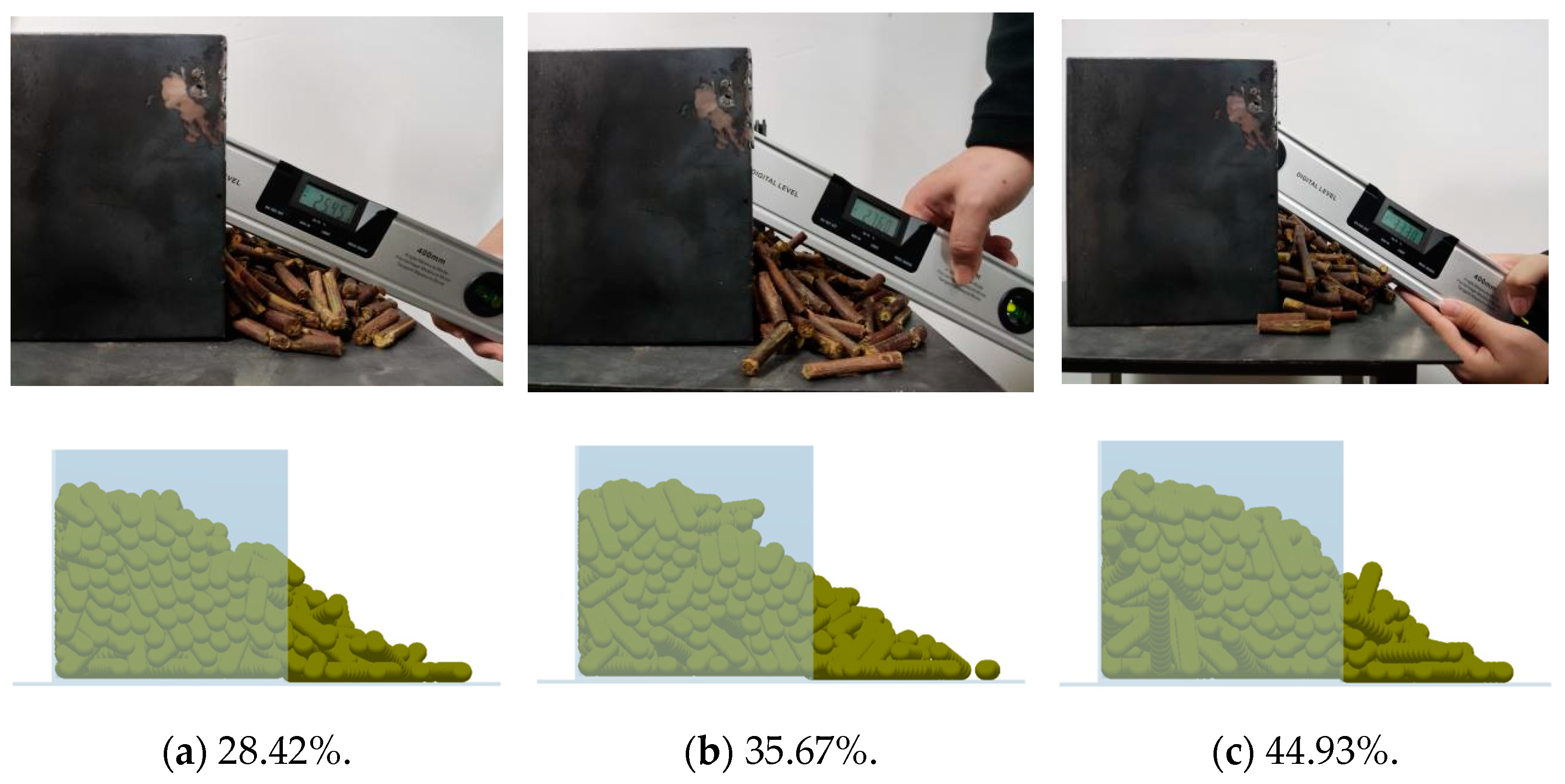
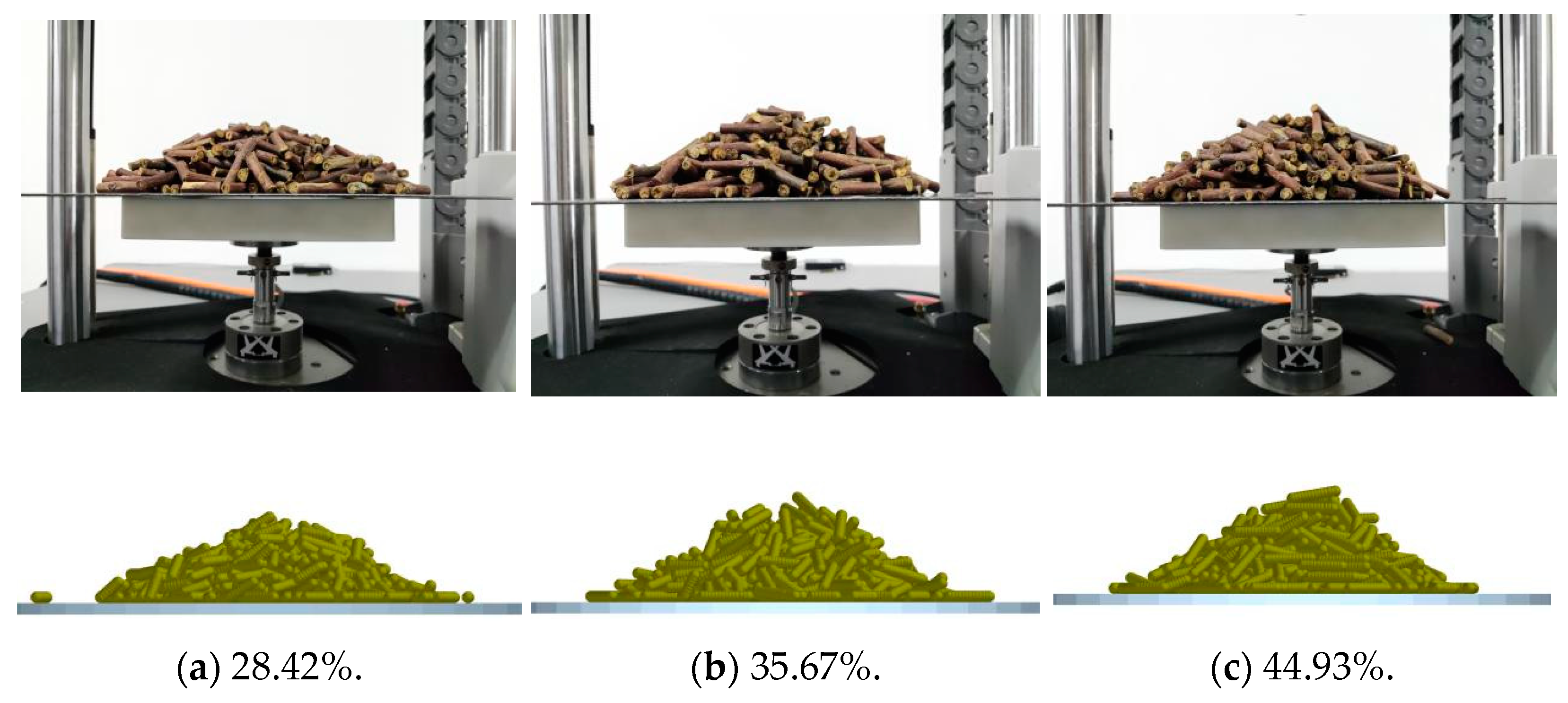
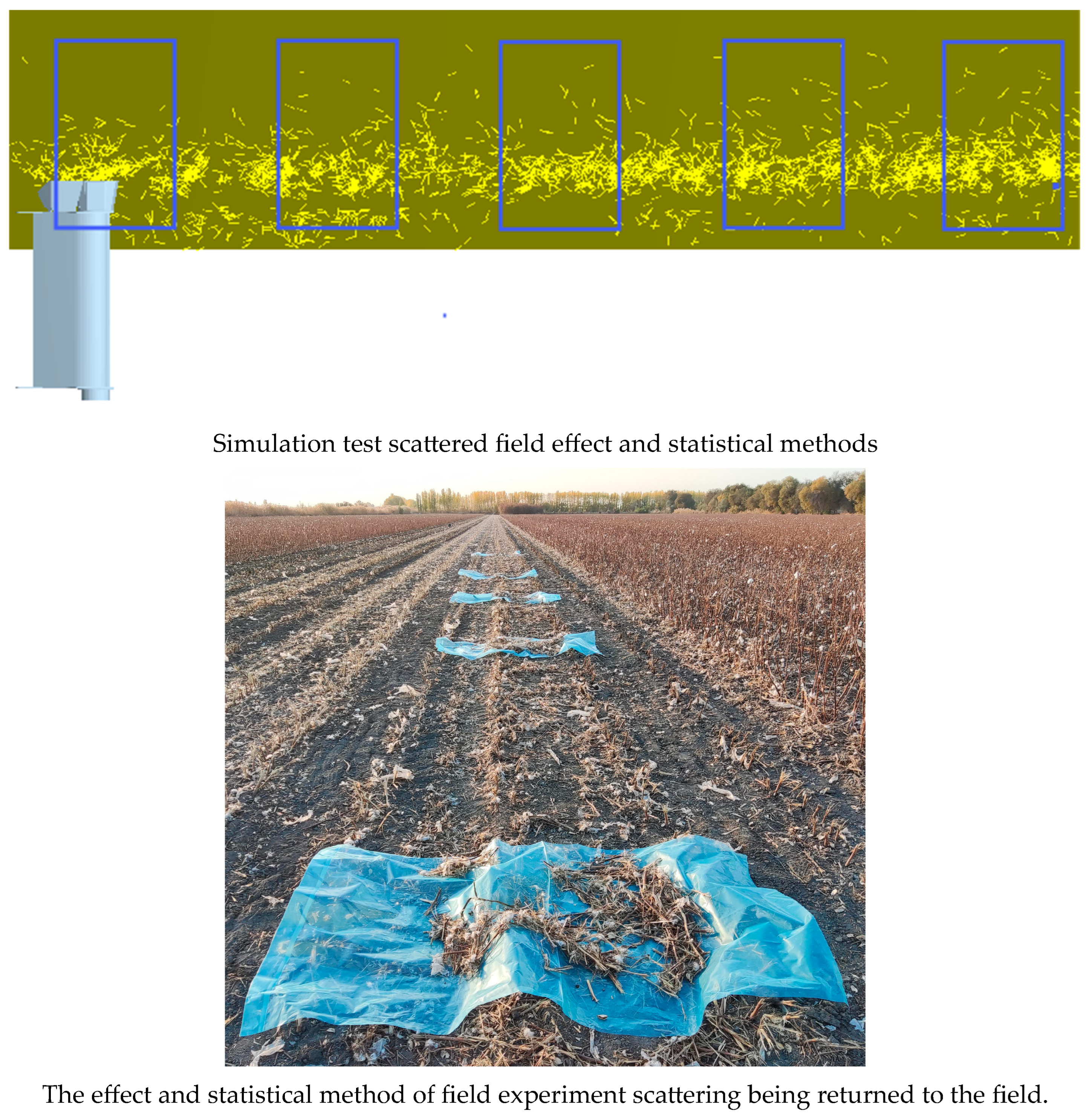
| Material | Density/(g cm−3) | Poisson Ratio | Shear Modulus/GPa | Source |
|---|---|---|---|---|
| Cotton stalk | 1.06~1.28 | 0.35 | 0.69 | References [21,22] |
| Rolled steel | 7.85 | 0.30 | 79.4 | References [23,24] |
| Exposure Parameter | Numerical Value |
|---|---|
| Rolling friction coefficient between cotton stalks, X1 | 0.05~0.1 |
| Static friction coefficient between cotton stalks, X2 | 0.3~0.6 |
| Collision recovery coefficient between cotton stalks, X3 | 0.3~0.7 |
| Cotton stalk–steel rolling friction coefficient, X4 | 0.05~0.1 |
| Cotton stalk–steel static friction coefficient, X5 | 0.3~0.6 |
| Restitution coefficient of cotton stalk–steel collision, X6 | 0.3~0.7 |
| Parameter | Coding | ||
|---|---|---|---|
| −1 | 0 | 1 | |
| Cotton stalk density/(g·cm−3), x0 | 1.06 | 1.17 | 1.28 |
| Rolling friction coefficient between cotton stalks, x1 | 0.05 | 0.075 | 0.1 |
| Static friction coefficient between cotton stalks, x2 | 0.3 | 0.45 | 0.6 |
| Collision recovery coefficient between cotton stalks, x3 | 0.3 | 0.50 | 0.7 |
| Cotton stalk–steel rolling friction coefficient, x4 | 0.05 | 0.075 | 0.1 |
| Cotton stalk–steel static friction coefficient, x5 | 0.3 | 0.45 | 0.6 |
| Restitution coefficient of cotton stalk–steel collision, x6 | 0.3 | 0.50 | 0.7 |
| Water content/% | 52.13 | 46.79 | 39.61 | 32.01 | 26.47 | |
| Repose angle/(°) | 1 | 37.92 | 32.65 | 27.82 | 24.61 | 21.66 |
| 2 | 37.28 | 33.28 | 29.93 | 25.11 | 22.58 | |
| 3 | 39.19 | 35.06 | 28.56 | 25.84 | 23.99 | |
| 4 | 39.87 | 35.25 | 29.12 | 26.68 | 24.79 | |
| 5 | 40.34 | 36.51 | 30.87 | 26.81 | 24.88 | |
| mean value | 38.92 | 34.55 | 29.26 | 25.81 | 23.58 | |
| Standard deviation/(°) | 1.29 | 1.57 | 1.18 | 0.96 | 1.41 | |
| Serial Number | x0 | x1 | x2 | x3 | x4 | x5 | x6 | Repose Angle/(°) |
|---|---|---|---|---|---|---|---|---|
| 1 | −1 | 1 | −1 | 1 | 1 | −1 | 1 | 29.03 |
| 2 | 1 | 1 | −1 | 1 | 1 | 1 | −1 | 30.13 |
| 3 | 1 | 1 | −1 | −1 | −1 | 1 | −1 | 29.44 |
| 4 | 1 | −1 | −1 | −1 | 1 | −1 | 1 | 25.72 |
| 5 | −1 | 1 | 1 | −1 | 1 | 1 | 1 | 49.44 |
| 6 | 1 | −1 | 1 | 1 | 1 | −1 | −1 | 37.51 |
| 7 | 1 | −1 | 1 | 1 | −1 | 1 | 1 | 43.32 |
| 8 | −1 | −1 | −1 | 1 | −1 | 1 | 1 | 26.48 |
| 9 | −1 | −1 | −1 | −1 | −1 | −1 | −1 | 26.63 |
| 10 | −1 | 1 | 1 | 1 | −1 | −1 | −1 | 44.43 |
| 11 | 1 | 1 | 1 | −1 | −1 | −1 | 1 | 44.54 |
| 12 | −1 | −1 | 1 | −1 | 1 | 1 | −1 | 43.65 |
| Parameter | Effect | Mean Square | p | Saliency List |
|---|---|---|---|---|
| x0 | −1.5 | 6.75 | 0.1471 | 4 |
| x1 | 3.95 | 46.81 | 0.0091 ** | 2 |
| x2 | 15.91 | 759.38 | <0.0001 ** | 1 |
| x3 | −1.42 | 6.05 | 0.1646 | 5 |
| x4 | 0.11 | 0.0341 | 0.9046 | 7 |
| x5 | 2.43 | 17.76 | 0.0436 * | 3 |
| x6 | 1.12 | 3.79 | 0.2501 | 6 |
| Serial Number | x1 | x2 | x5 | Simulation Accumulation Angle/(°) | Relative Error/% |
|---|---|---|---|---|---|
| 1 | 0.05 | 0.3 | 0.3 | 26.83 | 8.305 |
| 2 | 0.06 | 0.35 | 0.35 | 27.53 | 5.913 |
| 3 | 0.07 | 0.4 | 0.4 | 30.03 | 2.632 |
| 4 | 0.08 | 0.45 | 0.45 | 33.51 | 14.525 |
| 5 | 0.09 | 0.5 | 0.5 | 37.56 | 28.336 |
| Coding | Parameter | ||
|---|---|---|---|
| x1 | x2 | x5 | |
| −1 | 0.06 | 0.35 | 0.35 |
| 0 | 0.07 | 0.40 | 0.40 |
| 1 | 0.08 | 0.45 | 0.45 |
| Serial Number | x1 | x2 | x5 | Simulation Accumulation Angle/(°) |
|---|---|---|---|---|
| 1 | −1 | 1 | 0 | 52.66 |
| 2 | 0 | 0 | 0 | 36.55 |
| 3 | 0 | 0 | 0 | 32.21 |
| 4 | 0 | 0 | 0 | 38.19 |
| 5 | −1 | 0 | 1 | 49.36 |
| 6 | 0 | 0 | 0 | 42.48 |
| 7 | 0 | 0 | 0 | 35.97 |
| 8 | −1 | 0 | −1 | 20.99 |
| 9 | −1 | −1 | 0 | 33.51 |
| 10 | 1 | 0 | 1 | 53.18 |
| 11 | 0 | 1 | −1 | 35.63 |
| 12 | 1 | −1 | 0 | 44.94 |
| 13 | 1 | 0 | −1 | 33.25 |
| 14 | 0 | −1 | 1 | 46.84 |
| 15 | 1 | 1 | 0 | 57.92 |
| 16 | 0 | −1 | −1 | 23.51 |
| 17 | 0 | 1 | 1 | 56.46 |
| Source of Variance | Mean Square | Degree of Freedom | Average Square | F | p |
|---|---|---|---|---|---|
| Model | 1840.91 | 9 | 204.55 | 20.08 | 0.0003 ** |
| x1 | 134.23 | 1 | 134.23 | 13.18 | 0.0084 ** |
| x2 | 362.75 | 1 | 362.75 | 35.61 | 0.0006 ** |
| x5 | 1068.61 | 1 | 1068.61 | 104.90 | <0.0001 ** |
| x12 | 80.82 | 1 | 80.82 | 7.93 | 0.0259 * |
| x22 | 141.46 | 1 | 141.46 | 13.89 | 0.0074 ** |
| Residual error | 71.30 | 7 | 10.19 | ||
| Misfit term | 15.68 | 3 | 5.23 | 0.3759 | 0.7762 |
| Pure error | 55.62 | 4 | 13.91 | ||
| Summation | 1912.22 | 16 |
| Water Content/% | Physical Test Stacking Angle/(°) | Rolling Friction Coefficient between Cotton Stalks | Static Friction Coefficient between Cotton Stalks | Cotton Stalk–Steel Static Friction Coefficient | Simulation Accumulation Angle/(°) | Relative Error/% |
|---|---|---|---|---|---|---|
| 26.47 | 23.58 | 0.068 | 0.385 | 0.360 | 23.17 | 1.74 |
| 32.01 | 25.81 | 0.061 | 0.397 | 0.364 | 26.21 | 1.55 |
| 39.61 | 29.26 | 0.074 | 0.413 | 0.353 | 30.04 | 2.67 |
| 46.79 | 34.55 | 0.063 | 0.384 | 0.399 | 33.98 | 1.65 |
| 52.13 | 38.92 | 0.074 | 0.355 | 0.406 | 38.65 | 0.69 |
| Water Content/% | Formula Stacking Angle/(°) | Rolling Friction Coefficient between Cotton Stalks | Static Friction Coefficient between Cotton Stalks | Cotton Stalk–Steel Static Friction Coefficient | Simulation Accumulation Angle/(°) | Physical Test Stacking Angle/(°) | Relative Error/% |
|---|---|---|---|---|---|---|---|
| 28.42 | 24.26 | 0.063 | 0.398 | 0.360 | 26.13 | 25.45 | 2.67 |
| 35.67 | 27.29 | 0.065 | 0.384 | 0.374 | 28.36 | 27.60 | 2.75 |
| 44.93 | 33.03 | 0.063 | 0.385 | 0.393 | 33.65 | 33.30 | 1.05 |
| Water Content/% | Formula Stacking Angle/(°) | Rolling Friction Coefficient between Cotton Stalks | Static Friction Coefficient between Cotton Stalks | Cotton Stalk–Steel Static Friction Coefficient | Simulation Accumulation Angle/(°) | Physical Test Stacking Angle/(°) | Relative Error/% |
|---|---|---|---|---|---|---|---|
| 28.42 | 24.26 | 0.063 | 0.398 | 0.360 | 24.40 | 24.85 | 1.81 |
| 35.67 | 27.29 | 0.065 | 0.384 | 0.374 | 28.03 | 27.27 | 2.79 |
| 44.93 | 33.03 | 0.063 | 0.385 | 0.393 | 33.94 | 33.45 | 1.46 |
| Test Measuring Points | Simulation Test Dispersion Uniformity/% | Field Test Throwing Uniformity/% | Relative Error/% |
|---|---|---|---|
| 1 | 84.77 | 87.29 | 2.89 |
| 2 | 86.12 | 83.74 | 2.76 |
| 3 | 86.65 | 82.53 | 4.75 |
Disclaimer/Publisher’s Note: The statements, opinions and data contained in all publications are solely those of the individual author(s) and contributor(s) and not of MDPI and/or the editor(s). MDPI and/or the editor(s) disclaim responsibility for any injury to people or property resulting from any ideas, methods, instructions or products referred to in the content. |
© 2024 by the authors. Licensee MDPI, Basel, Switzerland. This article is an open access article distributed under the terms and conditions of the Creative Commons Attribution (CC BY) license (https://creativecommons.org/licenses/by/4.0/).
Share and Cite
Wu, T.; Yan, L.; Jiang, D.; Gou, H.; Fu, X.; Zhang, J. Establishment and Research of Cotton Stalk Moisture Content–Discrete Element Parameter Model Based on Multiple Verification. Processes 2024, 12, 1770. https://doi.org/10.3390/pr12081770
Wu T, Yan L, Jiang D, Gou H, Fu X, Zhang J. Establishment and Research of Cotton Stalk Moisture Content–Discrete Element Parameter Model Based on Multiple Verification. Processes. 2024; 12(8):1770. https://doi.org/10.3390/pr12081770
Chicago/Turabian StyleWu, Tao, Limin Yan, Deli Jiang, Haixiao Gou, Xuanhe Fu, and Jinhao Zhang. 2024. "Establishment and Research of Cotton Stalk Moisture Content–Discrete Element Parameter Model Based on Multiple Verification" Processes 12, no. 8: 1770. https://doi.org/10.3390/pr12081770




